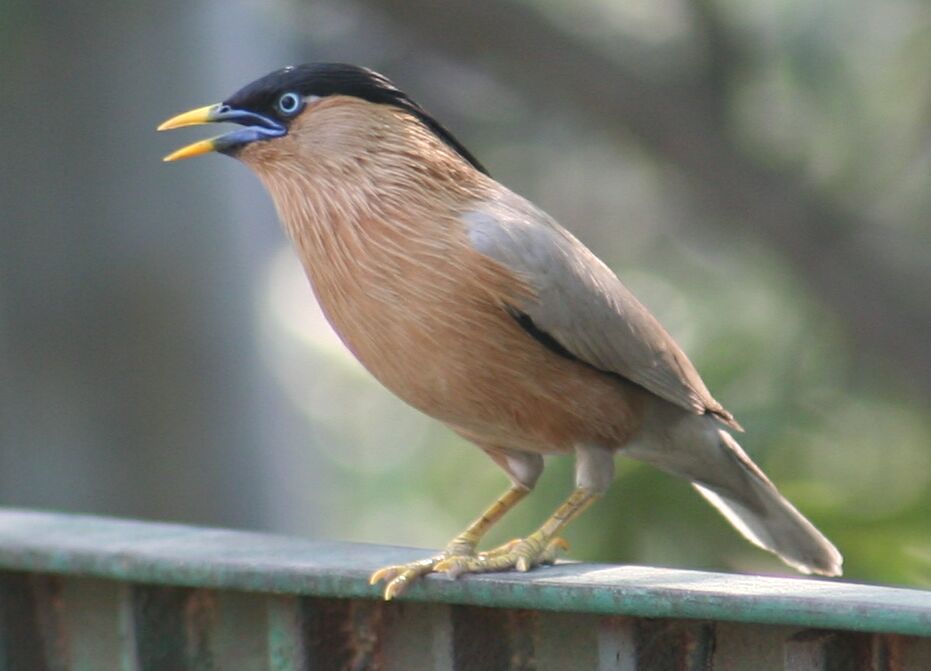- Brahminy Starling
Taxobox
name = Brahminy Starling

image_width = 240px
image_caption = Adult
status = LC
status_system = iucn3.1
regnum =Animal ia
phylum =Chordata
classis =Aves
ordo =Passeriformes
familia =Sturnidae
genus = "Sturnus " (but see text)
species = "S. pagodarum"
binomial = "Sturnus pagodarum"
binomial_authority = (Gmelin,1789 )
synonyms =See textThe Brahminy Myna (or "Mynah") or Brahminy Starling ("Sturnus pagodarum") is a member of the
starling family ofbird s. It is a resident breeder in easternAfghanistan ,Nepal ,India andSri Lanka .The adults of these 21cm-long birds have grey upperparts and reddish-orange underparts and black wing quills. The head has a black crown, nape and crest, and the underneath of the tail is white. The bill and the strong legs are bright yellow, and there are yellow wattles on the gape. The recumbent crest may be fluffed up when the bird is excited. The sexes are similar; young birds have crestless sooty brown head and dull general coloration.
Locally the bird is called "Bamani myna" (Bengal/Bihar), "Kalasir myna" (Hindi), "Pabiyapawi" (Uttar Bradesh), "Harbola" (Bengal), "Popoya myna", etc. It was known as "shaṇkarā" in
Sanskrit and compared to a "parivrājikā" (female ascetic wanderer) in theMahābhāṣya due to its serene appearance; the English name may reflect this or refer to the traditionalBrahmin "choti " hairstyle. The bird is popularly known as amyna - Salim Ali (1995) describes it as a "typical myna" in its behaviour and appearance -, whereas more recently (e.g. Grimmett "et al." 1999) the term "starling" is preferred.The truth is far more complex however: Mynas are not a natural,
monophyletic group, but a name for a number of unrelated South Asian starlings. The present species appears to be neatly intermediate between the "true" or typical mynas (genus "Acridotheres ") and some of the birds unequivocally termed "starlings". Its closest relatives are quite possibly the genus "Sturnia " - all called "starlings" - and theBali Myna , and together they apparently form a well-marked lineage. It is so distinctphylogenetic ally from other members of "Sturnus " that it might soon once more be removed to the distinctmonotypic genus "Temenuchus" or into "Sturnia".(Jønsson & Fjeldså 2006)This
passerine is typically found in dry forest and scrub jungle. Like most starlings, the Brahminy Starling is fairly omnivorous, eating fruit and insects. It builds a nest in holes. The normal clutch is 3-4 eggs.Galleria
References
* (1995): "The book of Indian Birds". Bombay Natural History Society, India.
*|year=2004|id=51905|title=Sturnus pagodarum|downloaded=20 July 2007 Database entry includes brief justification for why this species is of least concern.
* (1999): "Birds of India, Pakistan, Nepal, Bangladesh, Bhutan, Sri Lanka, and the Maldives". Princeton University Press, Princeton, N.J.. ISBN 0-691-04910-6
* (2006): A phylogenetic supertree of oscine passerine birds (Aves: Passeri). "Zool. Scripta" 35(2): 149–186. doi|:10.1111/j.1463-6409.2006.00221.x (HTML abstract)External links
* [http://ibc.hbw.com/ibc/phtml/especie.phtml?idEspecie=8372 Brahminy Starling videos] on the Internet Bird Collection
* [http://bird-photo-stories.blogspot.com/2007/04/brahminy-myna-swimming-pool.html The Brahminy Mynah thumbs his nose at the Babblers] (photo story)
Wikimedia Foundation. 2010.
